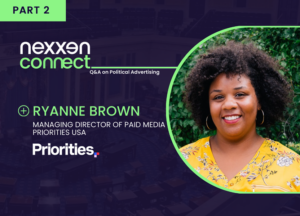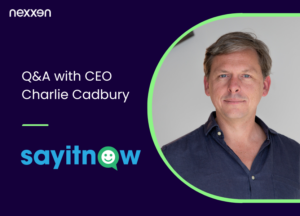

Nexxen Connect: Q&A on Political Advertising with Ryanne Brown – Part 1
This edition spotlights Ryanne Brown, Managing Director of Paid Media at Priorities USA.
Ryanne Brown has more than 14 years of experience working with a variety of Democratic campaigns, nonprofits, advocacy groups and ballot initiatives. She is currently the Managing Director of Paid Media at Priorities USA where she oversees all paid and organic media programs. Prior to joining Priorities, she served as the Managing Director at Do Big Things and the Deputy Digital Advertising Director at 270 Strategies where she worked with clients including Cory Booker 2020, Amy McGrath for Senate, Lauren Underwood for Congress, Community Change, NBCUniversal, BlackPAC, Supermajority and Rock the Vote. Ryanne is a Chicago native and a graduate of Marquette University.
Read below for part 1 of our discussion with Ryanne.

Ryanne Brown
Managing Director of Paid Media, Priorities USA
Priorities came out last year with an interesting article in the NY Times calling out contextual as the focus for targeting this cycle. How do you define contextual advertising, and why do you think it has value vs. other targeting strategies (e.g. first-party, voter file, etc.)?
I 100% think contextual targeting can have value over other strategies. To me, the benefit of contextual targeting is that it is specific enough to capture people’s attention (who are relevant and probably paying attention), but it’s still broad enough to be able to cast a wide net. I also think that it does a really good job of filling in the places where the other targeting tactics like first-party and look-alike don’t always do a great job. It helps fill in that full targeting circle that you’re looking for when you’re trying to reach an audience.
Contextual targeting to me is the ability to target people based on the content that they’re viewing and serving them ads that are relevant. So, an example of that is: if you are on a website about shoes and then you get an ad for a local shoe repair place – that’s contextual targeting.

Ryanne Brown
Managing Director of Paid Media, Priorities USA
This edition spotlights Ryanne Brown, Managing Director of Paid Media at Priorities USA.
Ryanne Brown has more than 14 years of experience working with a variety of Democratic campaigns, nonprofits, advocacy groups and ballot initiatives. She is currently the Managing Director of Paid Media at Priorities USA where she oversees all paid and organic media programs. Prior to joining Priorities, she served as the Managing Director at Do Big Things and the Deputy Digital Advertising Director at 270 Strategies where she worked with clients including Cory Booker 2020, Amy McGrath for Senate, Lauren Underwood for Congress, Community Change, NBCUniversal, BlackPAC, Supermajority and Rock the Vote. Ryanne is a Chicago native and a graduate of Marquette University.
Read below for part 1 of our discussion with Ryanne.
Priorities came out last year with an interesting article in the NY Times calling out contextual as the focus for targeting this cycle. How do you define contextual advertising, and why do you think it has value vs. other targeting strategies (e.g. first-party, voter file, etc.)?
I 100% think contextual targeting can have value over other strategies. To me, the benefit of contextual targeting is that it is specific enough to capture people’s attention (who are relevant and probably paying attention), but it’s still broad enough to be able to cast a wide net. I also think that it does a really good job of filling in the places where the other targeting tactics like first-party and look-alike don’t always do a great job. It helps fill in that full targeting circle that you’re looking for when you’re trying to reach an audience.
Contextual targeting to me is the ability to target people based on the content that they’re viewing and serving them ads that are relevant. So, an example of that is: if you are on a website about shoes and then you get an ad for a local shoe repair place – that’s contextual targeting.
To me, the benefit of contextual targeting is that it is specific enough to capture people's attention who are relevant and probably paying attention, but it's still broad enough to be relevant to the majority of users.
To me, the benefit of contextual targeting is that it is specific enough to capture people's attention who are relevant and probably paying attention, but it's still broad enough to be relevant to the majority of users.
When you say “don’t do a great job”, do you mean not a great job in getting full scale, or not a great job in level of prescriptiveness down to the interest?
It’s more about the scale. First-party data can also be incomplete. For example, I constantly get texts in my mom’s name about local Democrats, and I know that a first-party list is being used for that.
The long-awaited, long-promised cookiepocalypse will be happening this year, right in the middle of election season. How do you evaluate contextual as a potential solution to a cookieless world, vs. deterministic data (e.g. cookieless IDs)?
We’re moving towards contextual targeting for a reason. At Priorities, a lot of the reason why we’ve been focused on contextual leading up to the cycle – and doing as much research on it as we can – is to be able to share the successes with our partners for the next few election cycles.
On the Democratic side – we love a first party audience. And it’s a great place to start, but it’s not the full picture. So, this is our attempt to try to get people comfortable with the idea that contextual targeting is here, has always been here, is relevant, and you don’t need to be afraid of it or the CPMs that come along with it.
Gotcha. So in 5 years, which do you think will be the more utilized strategy – contextual or cookieless IDs?
I hope it’s contextual. It’s always been there in the background as an underutilized constant, though I’ve always used it. Cookieless IDs will be useful and needed, but I think contextual targeting is a better strategy.
The best way to source the data is to do the work, and see what works.
The best way to source the data is to do the work, and see what works.
Contextual as a targeting strategy – placing ad creatives directly into content relevant to the message – is powerful, but what other uses for contextual data, such as keyword cohorts of media consumption studies, get you most excited looking towards 2024?
Oh definitely keyword retargeting. No data is more rich than what people are literally searching for, picking up on and clicking on. And not just in your search bar, but in the articles when all the words are hyperlinked – there’s no richer data than proactive clicking on a thing to demonstrate interest and where they’re spending their time.
What is the best approach to source contextual data, given the familiar fragmentation problem across media outlets, social platforms, browsers, and streaming services?
At Priorities, we have a big focus on research – we do tons of polls against audiences. Earlier this year, we completed a media consumption survey to understand where people are spending their time. How we end up using targeting in our programs is guided by the media consumption surveys, polls, focus groups, and genuinely listening to folks about what they care about.
Also here at Priorities – we’re all digital people – we see what’s happening on the internet and can sprinkle in a little bit of common sense to our strategy development. For example, if someone isn’t all the way sold on Donald Trump, are they listening to a little bit of Fox News? Or what podcasts are they listening to in order to form their opinions? And how can we sneak a message into that podcast to counter it?
The best way to source the data is to do the work, and see what works.
Do you think contextual has the ability to be an adequate proxy for sentiment? How do you distinguish between someone consuming a topic because they love it or because they hate it?
I don’t think sentiment is the right word that we use. Instead, I’d use “curiosity”.
I think voters are smart and more curious than simply where they fall on a scale of Republican or Democrat. I think in this environment in particular, people are just always looking for some unbiased information, so they end up going to both ends of the spectrum trying to figure out the truth for themselves. More people spend a lot more time in that kind of curiosity bucket than they do in a sentiment bucket. Just because they are consuming something, that does not mean they necessarily believe it – they’re just trying to evaluate what is the truth for them.
Stay tuned for part 2 of our discussion with Ryanne Brown!
Read Next
Connect With Us
Learn how you can effectively and meaningfully leverage today’s video and CTV opportunities with our end-to-end platform, data and insights.


